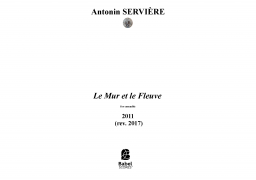Reverse
ISMN : 979-0-2325-6680-1
- Login to create your own lists
«Arirang» is a very old Korean folk song. And it is the most well-known Korean folk song. It is even used at football matches as a substitute for the Korean national anthem. UNESCO includes the song as part of the cultural heritage of mankind. But what lots of people actually do with this song is at least worth questioning.
I come from Korea and I live in Europe. I watch. I wonder: how much influence does the Asian culture have on the European culture in comparison with the influence that the European has on the Asian culture? There is the concept of "cultural exchange". That sounds good at first. But are there any actual exchanges?
«Arirang» is a monophonic song. The number of voices that want to interpret this unanimous song is immense. The global world differentiates itself and isolates itself simultaneously. There are all sorts of versions of the song, in every conceivable musical styles: from K-pop to pseudo-Mahler. Also, the song has been widely used by contemporary music composers. They've quoted it and reprocessed it, used and abused it: most often it is treated as a sentimental-patriotic gem. And the strange thing is that no one guessed that the song should sound “Authentic“. There are only interpretations, adaptations and "cover versions". And that is the negative side of globalization. Basically, it is a culture of forgetfulness.
In this piece «Reverse» my goal was to thematize this problem: the principle of the (false) (un)interpretation, of exaggeration, of over-abundance. The piece consists of 13 sections. Among them are 11 "cover versions" of "Arirang" in different styles of music that were decisive for the cultural import / export process in the course of the 20th century: Waltz (1910), Ragtime (1920), Boogie Woogie (1930), Swing ( 1940), Bossanova (1950), rock 'n' roll (1960), Disco (1970), New Age (1980), Techno (1990), Pop Funk (2000), EDM (Electronic Dance Music, 2010). In the piece, the sections do not occur in that chronological order, but are nested, so that the time intervals between musical eras reduce: [2010-1910] - [2000-1920] - [1990-1930] - [1980-1940] - [1970-1950] - [1960]. This form structure is complemented with two further sections: the last "cover version", in which the principle of exaggeration is taken to the extreme. The original song is most clearly recognizable in this section, however the instrumentation, the harmonies and the dynamics are absurd out. And this repeated several times, as an indication of the absurdity of permanent. Repetitive reinterpretations of the song is now reduced to a single score page. The principle of increasing the recognizability of the song is coupled with the increasing absurdity of the material treatment. It is also the reason for the title of this piece. On the aural level the process is reflected: inverted figures play an important role in the piece. For example, the typical „tam-tam“ sound is reversed compositionally: first comes the finale echo and then the impact. The ultimate part of the piece refers indirectly to the rest: a foreign body, a counterweight, a question mark.
In our world, many things happen. One can find good, bad or normal. Often one must accept it, but may not ignore it. Through ignorance we become numb. We still lack the real interest for each other, not only at the global level, between nations, continents and cultures, but often we also lack interest for our fellow human beings. And art is perhaps the only terrain, in which one can make this very clear.
Pages - 30







